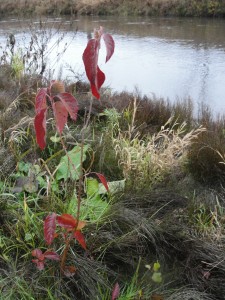In Burlington, VT, the Intervale is not only notable for providing a substantial amount of locally grown food within close proximity of an urban center, but also because of its location next to the Winooski River and its susceptibility to flooding. Given the recent increase in extreme events in the Northeast, it is no surprise that many of the farms located in the Intervale have faced a number of such flooding events over the past several years. These floods have at times proven devastating, and have caused many of the farmers to critically evaluate, and re-evaluate, their climate change resilience strategy. As part of a climate change resiliency and adaptive land use project by the Intervale Center, Maggie Donin surveyed all the current Intervale farms during the summer of 2014. She aimed to identify key climate change adaptation strategies employed by the farmers and to learn how farmers were planning for their future,  their businesses, and their livelihoods. The survey results confirm some of our previous observations of adaptation approaches by farmers in the region, but also shed light on some newer strategies. Below is a summary of the key findings:
their businesses, and their livelihoods. The survey results confirm some of our previous observations of adaptation approaches by farmers in the region, but also shed light on some newer strategies. Below is a summary of the key findings:
The survey results indicated that some farmers are hesitant to attribute erratic weather to climate change and see weather as an inherent risk to agriculture more generally. And though the Intervale is sometimes viewed as a more difficult place to farm with more weather risks (i.e., flooding), there also seems to be an understanding that farming is difficult everywhere. The surveyed farmers have developed some specific strategies to address the flooding risk and other climate threats on their land and are generally using strategies that align with their central values as sustainable agricultural practitioners – community relationship building, soil preservation, diversification of crops among others.
These are the key business adaptations identified by farmers:
- Purchase flood insurance
- Maintain honest relationships with customers so that they understand the risks the farm faces
- Add a Community Supported Agriculture program (CSA) to their farm or increase size of existing CSA
- Reduce excess product going to current CSA customers (from 50-60% excess to 30%) and sell that difference to wholesale markets. Build financial cushion with profits.
- Process excess crops to use in CSA for different seasons
- Extend CSA season to year round to spread out cash flow
- Build other skills outside of farming for income in an emergency scenario
- Use existing knowledge and skill set for paid speaking engagements and other educational opportunities
So far, the most successful strategies have been growing on less flood prone land, building high tunnels and greenhouses, and having a diversity of markets and production so that one event doesn’t affect everything on your farm.
In terms of recommending strategies to others, one farm said that the strategies they were using felt effective, but others need to find approaches that work for them. Other farmers stated the importance of building a portfolio of strategies and of having a financial buffer when you begin farming so that you can deal with potential disaster and loss of revenue.
Overall, this survey demonstrated that farmers clearly understand that there are many risks facing their farms each season, not just extreme weather. The Intervale farmers have decided that the benefits outweigh the risks. Regardless of their location, weather related challenges will always pose risks for farming. These farmers have found that many of the strategies to mitigate risks and increase resiliency to extreme weather align with their practices for sustainable and organic agriculture. These practices and techniques include managing healthy soils, diversifying crops for different markets, and building human and social capital, all of which are the basis for sustainable farm businesses. While extreme and erratic weather and inexorable climate change will never be in farmers’ complete control, the Intervale farmers in Burlington, Vermont are relying on core concepts of sustainable agriculture to deal with an uncertain future.
In the next blog, we’ll highlight the key production adaptions reported by Intervale farmers. Many thanks to Maggie Donin for her guest contribution to our blog!

